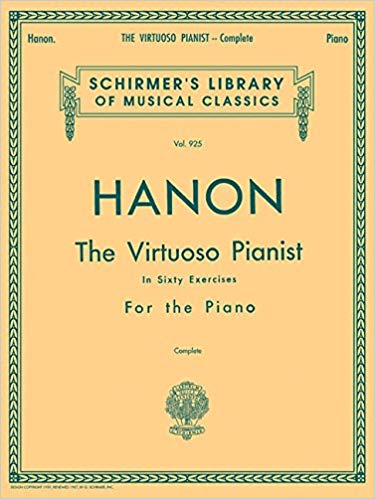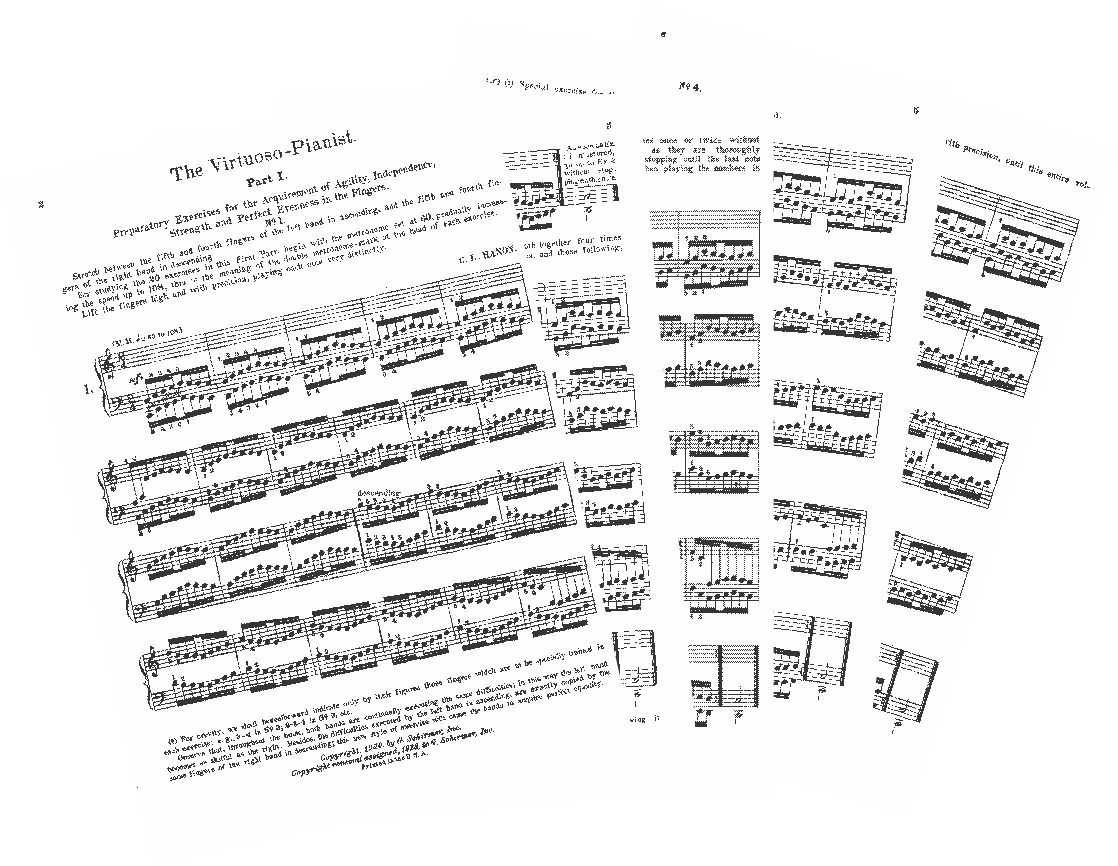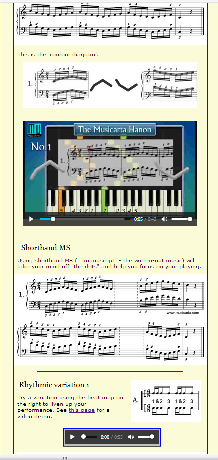- Hanon Finger Exercises -
The Musicarta Hanon

Anybody hoping to become or remain a proficient keyboard player needs daily technical practice to develop and maintain their skills.
The Hanon finger exercises have been a staple of piano teaching for a century and a half - and with good reason. They are easy to understand and play, and train the fingers as well as warming the hands up nicely for repertoire practice and performance.
Why another edition of Hanon exercises?
 The original exercises - not a pretty sight!
The original exercises - not a pretty sight!There is no shortage of free Hanon finger exercises to download, so
you might wonder why Musicarta expects you to pay for a new version!
The problem with the original exercises is two-fold. Firstly, they span two octaves - more than needed - and present a dense and off-putting appearance which puts off a lot of beginners and stifles critical practice.
Secondly, once you know the exercises, it's easy to lapse into mechanical repetition - and miss out on an excellent opportunity to develop your keyboard smarts!
 Intuitive, visual presentation
Intuitive, visual presentationThe Musicarta Hanon addresses these shortcomings by presenting video performances of the exercises, so that you copy a simple performance rather than grappling with a sea of dots - which automatically lets non-readers get the benefit too.
The screen shot on the right shows a typical Musicarta Hanon web page - a much more inviting experience!
The exercises are presented over one octave only, with lots of visual cues to help reduce dependence on the written music - like the 'contour line' shapes which mirror the up-down (pitch) shape of each exercise.
The more quickly you can see and play 'the pattern' rather than the music, the sooner you will listen to your own performance and truly let the exercise improve your technique.
Watch this introductory video!
A tour of the Musicarta Hanon video course
Every experienced musician will tell you that daily practice is the only way to be able to play the music you want to hear! The Hanon exercises have served this purpose for decades.
But the Musicarta Hanon is practicing like you've never seen it before!
The first Hanon exercise sounds like this.
A perfect, simple opportunity to drill your fingers in playing what you want, when you want it!
So, to start, all you will do is get acquainted with the Hanon exercises, numbers 1 through 30.
Hanon Combined Patterns
Once you can play the basic Hanon exercises reasonably fluidly, you'll be ready to challenge yourself to combine pairs of exercises by playing alternating bars of each.
Here's Exercises One and Two combined in this way.
The challenge is to hold in your attention 'where you are', and play the right pattern without hesitation.
Hanon in Six-Eight
At any time, you can vary your practice playing Hanon in a light, tripping six-eight version. Here's an example.
Hanon in Sixths and Tenths
Playing the exercises in sixths (with the left hand starting on E) and tenths (right hand, ditto) feels like 'getting music for free'!
Here's Hanon No.5 in tenths.
Playing in sixths and tenths makes it more obvious if your hands are not playing perfectly together - but, like all practicing, listening carefully is essential.
You can play the six-eight versions in sixths and tenths, too.
Hanon with Held Thumbs
The right hand in popular music keyboard styles often plays both chord tones (or a chord tone) in the lower/thumb side, and melody notes with the little finger side - both at the same time.
You start practicing this crucial but challenging technique with just the right hand.
The left can also join in. Playing like this makes you very aware of how long notes last - something you're responsible for, of course!
Rhythmic Variations - First Series
These rhythmic patterns in six eight will 'crisp up' your playing and offer an excellent daily opportunity to practice syncopated finger patterns.
Complex patterns are rehearsed in a static five-finger position first before being 'unleashed' on the Hanon exercises themselves.
Musicarta doesn't just drop you in at the deep end though. Here's how you build up the syncopation.
Nobody gets left behind!
Rhythmic Variations - Second Series
The second series offers a selection of rhythmic variations in four-four. Here's one practice-speed example.
Hanon Canon
Knowing the Hanon exercises well provides an opportunity to develop critical keyboard skills other than simple dexterity. This mini-series applies the contrapuntal 'canon' construction to the familiar Hanon exercises.
Here's the familiar Hanon No.1 with the left hand coming in a quaver late.
"Mind the Gap"
The original Hanon exercises for the most part follow the shape of the (right) hand and place the principal 'skip' (third) between the thumb and the index finger.
Varying the Hanon No.1 pattern by moving the skip to between RH fingers 2 and 3, or 3 and 4 (and so on) offers a useful opportunity to prepare the hand for a greater variety of demands.
Here's an example.
Spreading the Hand
The Hanon exercises mostly cover no greater a span than a sixth - hardly much of a challenge! This series of variations expands the span of the exercises first to a seventh, and then to a whole octave.
Here's one of the versions, spanning a seventh and rising by thirds.
Touch and dynamic variations
The Hanon exercises offer an excellent opportunity to practice keyboard touch (staccato-legato), phrasing, and (soft-loud) dynamics.
Here's the kind of variation you might find yourself playing once you've loosened up and 'given yourself permission' to experiment.
You'll keep revisiting this page for daily inspiration - and a new angle on what 'practicing' is all about...
Being a musician!
It's never too late - or too early - to start developing your keyboard skills in a structured, progressive way. The Musicarta Hanon is a great investment in your creative musical life! Take that step now, and reap the benefits for years to come.
|
|
Sign up for the Musicarta News! Get an overview of Musicarta in manageable monthly slices, keep up to date with new postings and get the latest discount codes. The Musicarta News - regular encouragement to learn and progress! |
|
OUT NOW! |
THE MUSICARTA BEAT & RHYTHM WORKBOOK At last! An effective approach to keyboard rhythm & syncopation skills. Learn more! |
ONLY $24.95! |